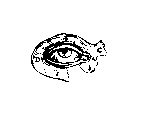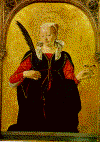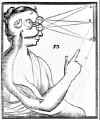 "The eye is like a mirror, and the
visible object is like the thing reflected in the mirror." -- Avicenna,
early 11th century
"The eye is like a mirror, and the
visible object is like the thing reflected in the mirror." -- Avicenna,
early 11th century
A HISTORY OF THE EYE
 "The eye is like a mirror, and the
visible object is like the thing reflected in the mirror." -- Avicenna,
early 11th century
"The eye is like a mirror, and the
visible object is like the thing reflected in the mirror." -- Avicenna,
early 11th century
The eye has been the subject of conflicting interpretations since antiquity. Many ancient physicians and philosophers believed in the idea of the active eye. Plato, for instance, wrote in the fourth century B. C. that light emanated from the eye, seizing objects with its rays. More metaphorically, Aristotle's disciple, Theophrastus, wrote that the eye had "the fire within." In saying this, he departed from the ideas of his teacher, since Aristotle was among the first to reject the extramission theory of vision. "In general, it is unreasonable to suppose that seeing occurs by something issuing from the eye," he declared. Aristotle advocated for a theory of intromission by which the eye received rays rather than directed them outward.
In the second century A. D., Galen had at least two different theories of the eye to choose from. He chose the extramission theory because it corresponded well with his image of sight as a function of an optical pneuma, flowing forth from the brain to the eyes through hollow optic nerves. Galen defined many of the fundamental features of the anatomy and physiology of the eye until the seventeenth century. Benefiting from the work of the anatomists who dissected in Alexandria, such as Rufus of Ephesus, he described the retina, cornea, iris, uvea, tear ducts, and eyelids, as well as two fluids he called the vitreous and aqueous humors. He noted some of the peculiar features of sight such as binocular vision. Galen paid particular attention to the crystalline lens, which he described as a round lens in the middle of the eye. He concluded: "the crystalline lens is the principal instrument of vision, a fact clearly proved by what physicians call cataracts, which lie between the crystalline humor and the cornea and interfere with vision until they are couched."
The eye was a subject of special interest in medieval Islamic medicine and philosophy. Between the ninth and fourteenth centuries, dozens of specialized treatises on ophthalmology appeared. Influenced by their readings of Galen, the majority of Islamic scholars, such as al-Kindi and Hunain ibn Ishaq (Johannitius) in the ninth century, favored the extramission theory of sight. The latter, in such works as Ten Treatises on the Eye and the Book of the Questions on the Eye, elaborated on the series of tunics behind the vitreous humor, paying special attention to the retina, whose role was to nourish the vitreous humor and conduct visual spirit through the hollow optic nerve. He further reinforced the centrality of the crystalline lens.
Islamic physicians actively debated many details of the eye, among them, the number of tunics and, most importantly, the theory of extramission. In the early tenth century, the great Baghdad clinician al-Razi (Rhazes) noted the pupil's contraction and dilation; a century later, al-Haythan (Alhazen) noted in his Book of Optics that the eye was injured by strong light. Both scholars reasonably concluded that the light affected the eye and not vice-versa. Alhazen's contemporary, Avicenna, offered a more systematic critique of the Galenic account of the eye as part of his overall adherence to Aristotelian theory. While retaining many features of Galen's anatomy -- the hollow nerves and crystalline lens -- he nonetheless argued for intromission.
As this rich body of literature was translated from
Arabic into Latin in the eleventh through thirteenth centuries, medieval
European medical practitioners had a great deal to puzzle over. Generally,
they were le ss taken with the extramission theory than their Islamic
predecessors; this was partly due to the importance of Avicenna in the medieval
and Renaissance medical curriculum. In the late twelfth century, Master
Nicolaus wrote: "The optic nerve, which descends from the brain to the eyes, passes
through the center of the eye as far as the crystalline humor, through it
comes the visible spirit, and as it emerges through the uveal tonic and
the cornea it is mingled with clean air and transports its rays to the body,
and thus sight is brought about." Such ideas reflected the intensive
reading of Islamic medical texts then underway. Look at the
thirteenth-century image of the eye to your left. What features of ancient
and medieval optic theory do you see?
ss taken with the extramission theory than their Islamic
predecessors; this was partly due to the importance of Avicenna in the medieval
and Renaissance medical curriculum. In the late twelfth century, Master
Nicolaus wrote: "The optic nerve, which descends from the brain to the eyes, passes
through the center of the eye as far as the crystalline humor, through it
comes the visible spirit, and as it emerges through the uveal tonic and
the cornea it is mingled with clean air and transports its rays to the body,
and thus sight is brought about." Such ideas reflected the intensive
reading of Islamic medical texts then underway. Look at the
thirteenth-century image of the eye to your left. What features of ancient
and medieval optic theory do you see?
Renaissance anatomists learned a great deal about
the anatomy of the eye. Leonardo da Vinci, for exam ple, fundamentally transformed his theory of vision. In
the 1480s, Leonardo had advocated the extramission theory. By the 1490s,
he had reversed his position. In his instance, his shifting viewpoint may
have been more theoretical than observational since his image of the eye was
basically two concentric spheres -- far less sophisticated than Galen's
even. "The eye, the instrument
of vision, is hidden in the cavity above, and in that below is the humor
which nourishes the roots of the teeth," he wrote rather generically.
Yet he was clearly fascinated by the effect of light
on the living eye, examining the pupil with some care.
ple, fundamentally transformed his theory of vision. In
the 1480s, Leonardo had advocated the extramission theory. By the 1490s,
he had reversed his position. In his instance, his shifting viewpoint may
have been more theoretical than observational since his image of the eye was
basically two concentric spheres -- far less sophisticated than Galen's
even. "The eye, the instrument
of vision, is hidden in the cavity above, and in that below is the humor
which nourishes the roots of the teeth," he wrote rather generically.
Yet he was clearly fascinated by the effect of light
on the living eye, examining the pupil with some care.
In the sixteenth century, the basic theory of sight remained in place though many physical features of the eye were described differently. Alessandro Achillini, for example, may have been the first to challenge the idea of the crystalline lens as the main organ of sight. Vesalius retained the primacy of the crystalline lens, but strongly denied that the optic nerves were hollow. By mid-century, anatomists had begun to look more closely at the crystalline humor, which no longer seemed round and centered but more oblong and towards the front of the eye. Finally, in 1583 a Swiss physician Felix Platter argued that the optic nerve out to be viewed as the "primary organ of vision." He relegated the crystalline humor to a secondary role, elevating the status of the retina.
In 1604, Kepler, a close reader of Alhazen, offered
the first theory of the retinal image.  "Therefore vision occurs
"Therefore vision occurs  through a picture of the visible things on the white, concave
surface of the retina." The eye was now a camera obscura -- an
apt image in an era obsessed with the science of perspective. This image
of sight to the left, from Descartes' Dioptrics, suggests how much new
theories of sight placed greater emphasis on the fusion of anatomy and geometry
in studying the eye. Look at the image of the eye to your right, as
depicted by Kepler's contemporary Robert Fludd, who disagreed quite a bit with
Kepler's idea of the retinal image as an image that had been reversed and then
restored through the process of reflection and refraction. Why do you
think it was so difficult to image that the eye operated according to the same
principles as the lens in Kepler's telescope, which showed the heavens upside
down?
through a picture of the visible things on the white, concave
surface of the retina." The eye was now a camera obscura -- an
apt image in an era obsessed with the science of perspective. This image
of sight to the left, from Descartes' Dioptrics, suggests how much new
theories of sight placed greater emphasis on the fusion of anatomy and geometry
in studying the eye. Look at the image of the eye to your right, as
depicted by Kepler's contemporary Robert Fludd, who disagreed quite a bit with
Kepler's idea of the retinal image as an image that had been reversed and then
restored through the process of reflection and refraction. Why do you
think it was so difficult to image that the eye operated according to the same
principles as the lens in Kepler's telescope, which showed the heavens upside
down?
QUESTIONS: WHY DID ISLAMIC MEDICAL PRACTITIONERS MAKE THE EYE A SUBJECT OF SPECIAL STUDY? WHAT CULTURAL REASONS CAN YOU THINK OF THAT WOULD HAVE MADE THE EXTRAMISSION THEORY PREFERABLE?